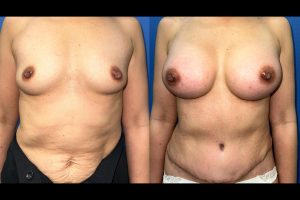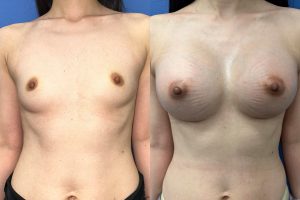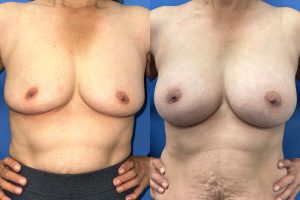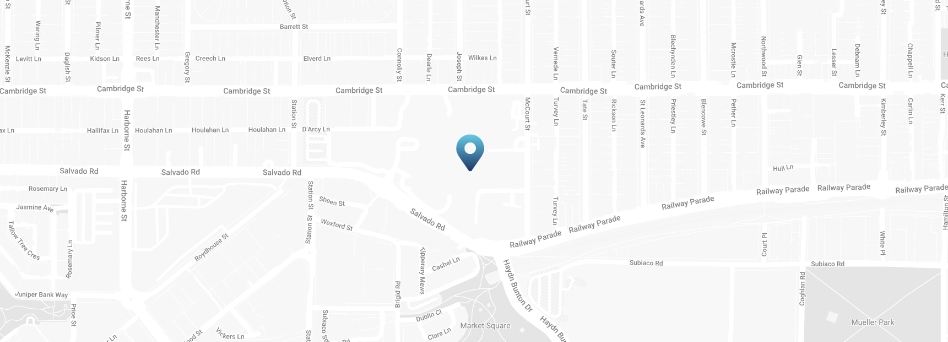Breast Augmentation
What is the breast augmentation procedure?
A breast augmentation with breast implants is designed to address aesthetic-based concerns. The procedure involves placing breast implants behind the breasts to increase their size and augment their shape.
There are several reasons why women choose to have breast implants, and the decision to undergo an augmentation is highly personal. Over time, the breasts can lose volume with age, hormonal changes, weight loss or after breastfeeding. A patient may want to change this with the use of implants and surgical adjustments.
The procedure can be highly personalised, with a variety of options for the shape, size, and positioning of breast implants. During your consultation with breast augmentation surgeon Dr Hanikeri in Perth, you will be able to discuss your concerns and the ideal results that you would like to achieve. The steps and details of the surgery can then be tailored to your specific needs and to best suit your unique features.
Benefits of breast augmentation surgery with Dr Hanikeri in Perth
Your procedure will be completely tailored to your needs, so you can experience the benefits of a personalised procedure with steps that are designed to achieve your desired results.
Breast augmentation surgery with breast implants can make desired changes to the shape and size of the breasts. Since every patient is different and will have their own personal preferences, the benefits of breast augmentation will vary for each patient.
The procedure can address asymmetry, breast size and shape, and creates a fuller appearance. If lifting is needed to achieve ideal results, breast augmentation may be able to be combined with a breast lift to address the position of the breasts, remove excess skin and change the position of the nipples.
As a qualified Plastic and Reconstructive Surgeon, Dr Hanikeri has undergone years of extensive training, with over 20 years of working in both Australia and overseas. He is a Founding member of the Western Australia Plastic Surgery Centre and a member of The Australian Society of Plastic Surgeons (ASPS), the Australasian Society of Aesthetic Plastic Surgeons (ASAPS) and the International Society of Aesthetic Plastic Surgeons (ISAPS). As well as performing plastic and reconstructive surgery, he has also utilised his knowledge to train and educate future plastic surgeons.
Breast augmentation costs in Perth
The costs of a breast augmentation procedure are personalised since each procedure will be tailored to suit the needs of each patient. Your breast augmentation surgeon Dr Hanikeri will assess your needs during a consultation, before designing an ideal treatment plan for you. When you agree on a treatment plan that you are happy with, our team can then provide a surgical fee estimate of how much your procedure will cost.
Your consultations
The fee for your initial consultation to discuss a breast augmentation procedure will be $250. This is required at the time of making a booking to secure your appointment. This amount is then deducted from the cost of your surgery, if you decide to proceed. The second consultation will then be $100.
Aftercare costs
We believe in providing exceptional support throughout your recovery journey. That is why post-operative check-ups, dressing changes, and suture removal are all included in the procedure cost and do not incur additional fees.
Your Surgical Fee Estimate form
Your breast augmentation surgery fees will include surgeon’s fees, anaesthetist fees and hospital fees.
The costs can be influenced by the complexity of the procedure, the type of implants chosen, and the duration of the procedure. Each of these factors will vary per patient, so you will discuss your procedure plan in detail during your consultation.
At the end of your consultation, you will receive a Surgical Fee Estimate form that details all of the fees above.
Payment plans
Our patients may wish to go on our payment plan before their procedure date. The full payment must be made by at least two weeks before the date of the procedure. Up until then, payments can be made in instalments, either weekly or monthly. This payment plan will be interest-free and will require a $500 deposit in the beginning to secure your procedure date.
As a Specialist Plastic Surgeon, we are not permitted to broker a third-party payment plan, as the Australian Society of Plastic Surgeons and AHPRA do not permit this.
To discuss your costs in further detail and receive your fee estimate form, please contact our team to book your consultation.







